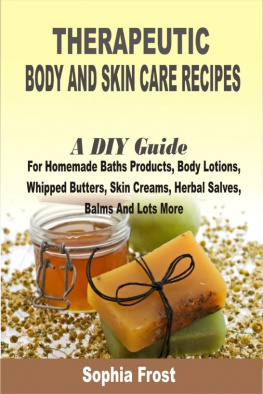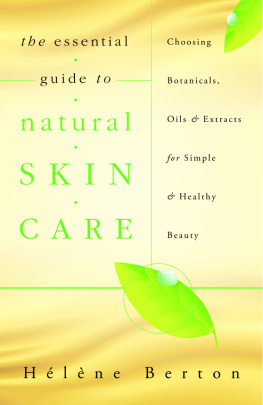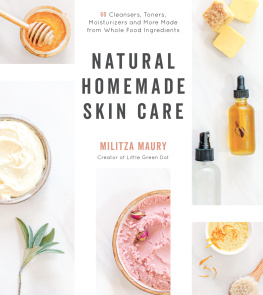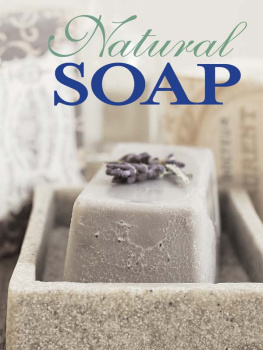Making Herbal
Hand Creams and Salves
Adapted from Natural Hand Care,
by Norma Pasekoff Weinberg

CONTENTS
The mission of Storey Publishing is to serve our customers by publishing practical information that encourages personal independence in harmony with the environment.
Editing and page layout by Nancy W. Ringer
Cover illustration by Laura Tedeschi
Cover design by Carol J. Jessop (Black Trout Design)
Text illustrations by Laura Tedeschi, except (top) by Randy
Mosher and (bottom) by Kathy Bray
2000 by Storey Publishing, LLC
All rights reserved. No part of this bulletin may be reproduced without written permission from the publisher, except by a reviewer who may quote brief passages or reproduce illustrations in a review with appropriate credits; nor may any part of this bulletin be reproduced, stored in a retrieval system, or transmitted in any form or by any means electronic, mechanical, photocopying, recording, or other without written permission from the publisher.
The information in this bulletin is true and complete to the best of our knowledge. All recommendations are made without guarantee on the part of the author or Storey Publishing. The author and publisher disclaim any liability in connection with the use of this information. For additional information please contact Storey Publishing, 210 MASS MoCA Way, North Adams, MA 01247.
Storey books and bulletins are available for special premium and promotional uses and for customized editions. For further information, please call 1-800-793-9396.
Printed in the United States by Excelsior
Library of Congress Cataloging-in-Publication Data
Weinberg, Norma Pasekoff.
Making herbal hand creams and salves / Norma Pasekoff Weinberg.
p. cm. (A Storey country wisdom bulletin; A-256)
Adapted from Natural hand care, by Norma Pasekoff Weinberg.
ISBN 978-1-58017-303-2 (pbk. : alk. paper)
1. HandCare and hygienePopular works. 2. SkinCare and hygienePopular works. 3. Herbal cosmetics. 4. Beauty, Personal.
I. Weinberg, Norma PasekoffNatural hand care. II. Title. III. Series.
RA776.5.W4382 2000
646.726dc21
00-038794
Your Hardworking Hands
Just about everyone has experienced dry skin, blisters, calluses, hangnails, and red, chapped skin on their hands. Why do you think there are so many lotions, creams, and salves specially designed for hand care in the beauty products aisle of your grocery store? If you stop for a moment to think about how much your hands do for you each day, youll appreciate the value of time spent nurturing and caring for these hardworking parts. Whether youre a mason lifting and setting rough, abrasive stone for hours on end; a gardener using shovels, rakes, and your bare hands to prepare the soil; or an office worker handling sheafs of paper all day long, your hands are likely to be dry, work-worn, and in need of some soothing relief from creams and salves.
Which lotions and creams are the best? The choice is yours. You might decide that at work you want a hand emollient that dries quickly and has no fragrance. At home you may opt for a thicker cream formula, one that you can wear all night with cotton gloves. If your hands are severely chapped and the skin is splitting, youll want some heavy-duty salve to heal and soothe the cracked skin. And as you grow older, youll want to use gentle, skin-nourishing lotions and creams every day to slow the effects of time.
Evaluating Commercial Products
Chances are that you wont always have the time or energy to make your own hand creams and salves. For healths sake, its important to be an informed consumer. These are some of the ingredients to know.
Allantoin
Allantoin is a substance that is soothing to the skin. It stimulates healthy tissue formation and healing of wounds, as well as removing the scales and crusting of dead skin cells. Allantoin has a softening effect on keratin, the protein that is so abundant in the surface cells of the skin, by allowing water to be replenished in the keratin layer. This ingredient is naturally found in the herbs aloe vera, comfrey, and bearberry.
Fresh from the Farm
Hand salves and creams have probably been around since the first peoples discovered bear grease. Many nineteenth-century hand products from the agricultural communities came with names like Absorbine Veterinary Liniment, Bag Balm, Corn Huskers Lotion, and White Cloverine Salve. Farmers began to try these products, on the theory that whats good for the horse is good for his owner.
One product, B and OR Hand Lotion, conceived and produced by Vermont pharmacists Beauchamp and ORourke, was devised to cope with the industrial revolution. It was intended to protect ironworkers hands from the temperature extremes of blast furnaces and the bitter Vermont cold. Witch hazel, camphor, soap liniment, glycerin, bay rum, rose water, and mutton tallow are some of the ingredients. Sadly, this product is no longer available.

Beneficial Herbs
There are numerous beneficial herbs for hand creams and ointment recipes including aloe, calendula, chickweed, comfrey, viola or garden pansy, plantain, red clover, St.-Johns-wort, and yarrow. Many are used as ingredients in commercial hand-care products.
Dead Sea Salt Extract
Dead Sea salt extract is full of vitamins and minerals and naturally increases the skins ability to retain moisture. It is an ingredient in some high-end cream moisturizers.
Glycerin
Glycerin is a substance that attracts water but is not easily absorbed, so it will remain on the upper layers of the skin. If 100 percent glycerin is applied as a humectant, it may draw additional moisture from already dry skin. However, since the concentration of glycerin in creams and lotions is usually never more than 50 percent, glycerin can be considered a beneficial ingredient because it improves a creams spreadability. Glycerin and rose water make a classic formulation that has been used safely for years.
Jojoba
Jojoba extract, commonly known simply as jojoba (pronounced ho-ho-ba), is similar to human sebum, the skins natural restorative fluid. It helps to restore the skin and softens and conditions all skin types. Jojoba is cold-pressed and filtered from the seeds of a desert shrub that is cultivated in dry regions of the world, such as Israel and the Sonoran desert regions of the United States and Mexico.
Jojoba extract is an unusual wax ester with antioxidant and light emollient properties. It rarely turns rancid and does not break down under high temperatures or pressure. Jojoba became an important ingredient for the natural-cosmetics industry when it was discovered to imitate the properties of spermaceti oil a white, crystalline, solid wax from the head of the sperm whale. Spermaceti oil was once used extensively in cosmetics, but has since been banned as a measure of protection for whales. Cetyl alcohol, a form of synthetic spermaceti oil, is an alternative to jojoba, but it can sometimes cause allergic skin reactions.
Lactic Acid











